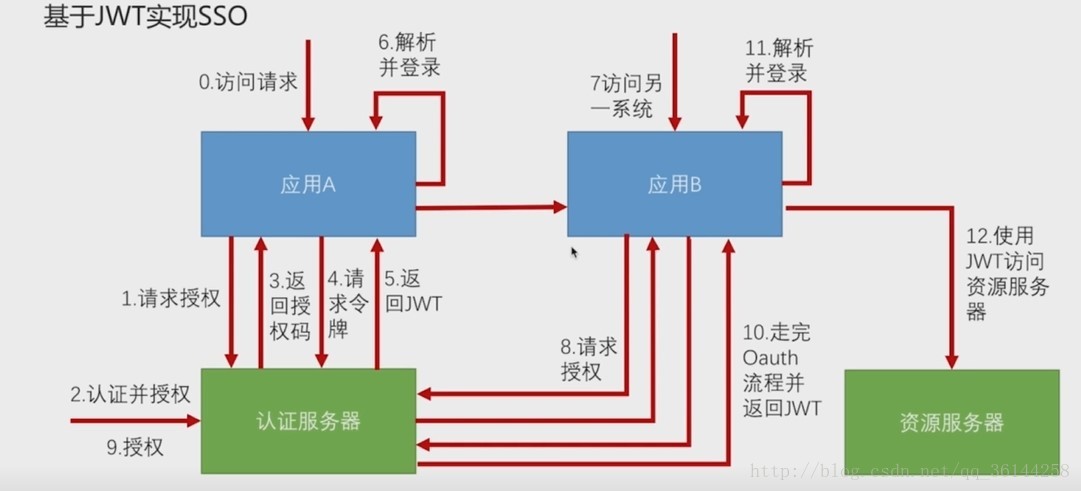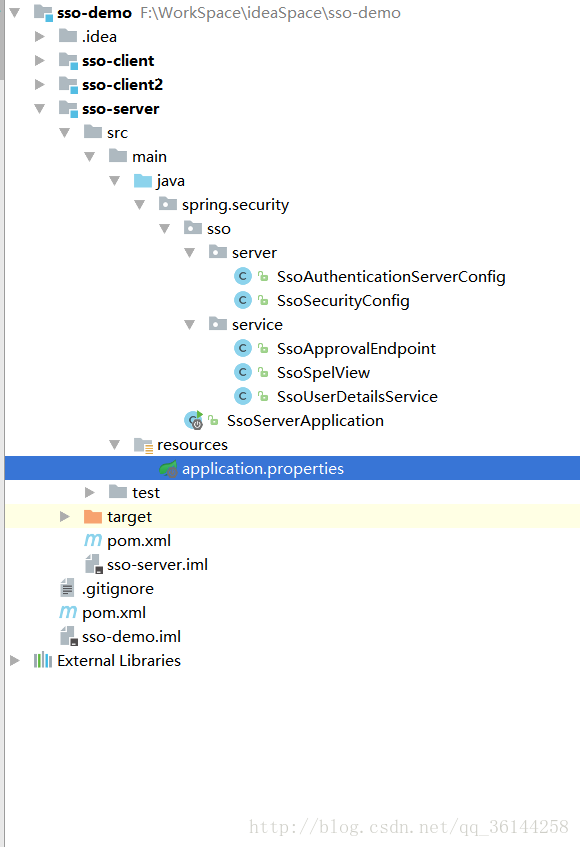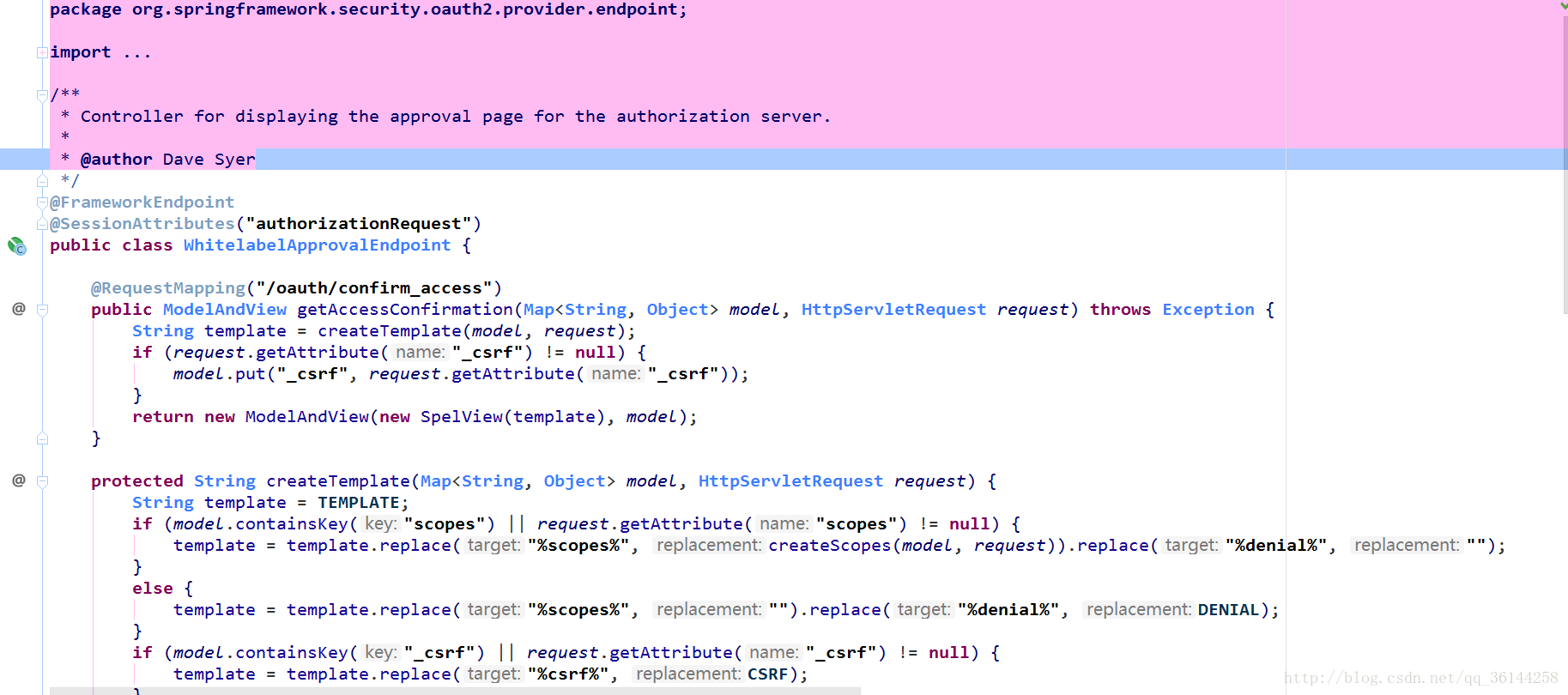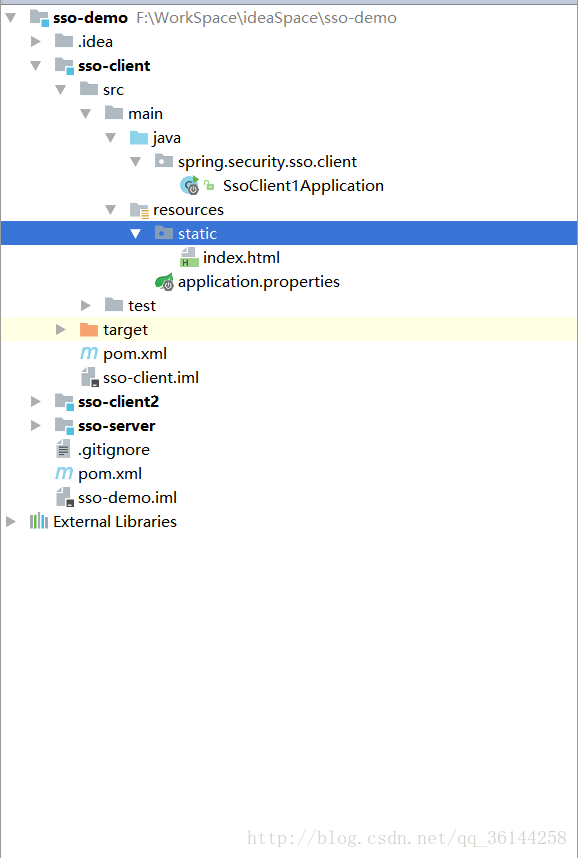Spring Security基于JWT实现SSO单点登录详解
人气:0SSO :同一个帐号在同一个公司不同系统上登陆

使用SpringSecurity实现类似于SSO登陆系统是十分简单的 下面我就搭建一个DEMO
首先来看看目录的结构

其中sso-demo是父工程项目 sso-client 、sso-client2分别对应2个资源服务器,sso-server是认证服务器
引入的pom文件
sso-demo
<?xml version="1.0" encoding="UTF-8"?>
<project xmlns="http://maven.apache.org/POM/4.0.0" xmlns:xsi="http://www.w3.org/2001/XMLSchema-instance"
xsi:schemaLocation="http://maven.apache.org/POM/4.0.0 http://maven.apache.org/xsd/maven-4.0.0.xsd">
<modelVersion>4.0.0</modelVersion>
<groupId>study.security.sso</groupId>
<artifactId>sso-demo</artifactId>
<version>1.0.0-SNAPSHOT</version>
<modules>
<module>sso-server</module>
<module>sso-client</module>
<module>sso-client2</module>
</modules>
<packaging>pom</packaging>
<dependencyManagement>
<dependencies>
<dependency>
<groupId>io.spring.platform</groupId>
<artifactId>platform-bom</artifactId>
<version>Brussels-SR4</version>
<type>pom</type>
<scope>import</scope>
</dependency>
<dependency>
<groupId>org.springframework.cloud</groupId>
<artifactId>spring-cloud-dependencies</artifactId>
<version>Dalston.SR2</version>
<type>pom</type>
<scope>import</scope>
</dependency>
</dependencies>
</dependencyManagement>
<build>
<plugins>
<plugin>
<groupId>org.apache.maven.plugins</groupId>
<artifactId>maven-compiler-plugin</artifactId>
<version>2.3.2</version>
<configuration>
<source>1.8</source>
<target>1.8</target>
<encoding>UTF-8</encoding>
</configuration>
</plugin>
</plugins>
</build>
</project>
sso-server
<?xml version="1.0" encoding="UTF-8"?>
<project xmlns="http://maven.apache.org/POM/4.0.0"
xmlns:xsi="http://www.w3.org/2001/XMLSchema-instance"
xsi:schemaLocation="http://maven.apache.org/POM/4.0.0 http://maven.apache.org/xsd/maven-4.0.0.xsd">
<parent>
<artifactId>sso-demo</artifactId>
<groupId>study.security.sso</groupId>
<version>1.0.0-SNAPSHOT</version>
</parent>
<modelVersion>4.0.0</modelVersion>
<artifactId>sso-server</artifactId>
<dependencies>
<dependency>
<groupId>org.springframework.boot</groupId>
<artifactId>spring-boot-starter-security</artifactId>
</dependency>
<dependency>
<groupId>org.springframework.boot</groupId>
<artifactId>spring-boot-starter-web</artifactId>
</dependency>
<dependency>
<groupId>org.springframework.security.oauth</groupId>
<artifactId>spring-security-oauth2</artifactId>
</dependency>
<dependency>
<groupId>org.springframework.security</groupId>
<artifactId>spring-security-jwt</artifactId>
</dependency>
</dependencies>
</project>
sso-client与sso-client2 pom 中的 是一样的
1.sso-server
现在开始搭建认证服务器
认证服务器的目录结构如下

/**
* 认证服务器配置
* Created by ZhuPengWei on 2018/1/11.
*/
@Configuration
@EnableAuthorizationServer
public class SsoAuthenticationServerConfig extends AuthorizationServerConfigurerAdapter {
@Override
public void configure(ClientDetailsServiceConfigurer clients) throws Exception {
clients.inMemory()
.withClient("client1")
.secret("client1")
.authorizedGrantTypes("authorization_code", "refresh_token")
.scopes("all")
.and()
.withClient("client2")
.secret("client2")
.authorizedGrantTypes("authorization_code", "refresh_token")
.scopes("all");
}
@Override
public void configure(AuthorizationServerEndpointsConfigurer endpoints) throws Exception {
endpoints.tokenStore(jwtTokenStore()).accessTokenConverter(jwtAccessTokenConverter());
}
/**
* 认证服务器的安全配置
*
* @param security
* @throws Exception
*/
@Override
public void configure(AuthorizationServerSecurityConfigurer security) throws Exception {
// 要访问认证服务器tokenKey的时候需要经过身份认证
security.tokenKeyAccess("isAuthenticated()");
}
@Bean
public TokenStore jwtTokenStore() {
return new JwtTokenStore(jwtAccessTokenConverter());
}
@Bean
public JwtAccessTokenConverter jwtAccessTokenConverter() {
JwtAccessTokenConverter jwtAccessTokenConverter = new JwtAccessTokenConverter();
// 保证JWT安全的唯一方式
jwtAccessTokenConverter.setSigningKey("ZPW");
return jwtAccessTokenConverter;
}
}
/**
* 自定义用户登陆逻辑配置
* Created by ZhuPengWei on 2018/1/13.
*/
@Configuration
public class SsoSecurityConfig extends WebSecurityConfigurerAdapter {
@Autowired
private UserDetailsService userDetailsService;
/**
* 加密解密逻辑
*/
@Bean
public PasswordEncoder passwordEncoder() {
return new BCryptPasswordEncoder();
}
@Override
protected void configure(HttpSecurity http) throws Exception {
// 改成表单登陆的方式 所有请求都需要认证
http.formLogin().and().authorizeRequests().anyRequest().authenticated();
}
@Override
protected void configure(AuthenticationManagerBuilder auth) throws Exception {
// 用自己的登陆逻辑以及加密器
auth.userDetailsService(userDetailsService).passwordEncoder(passwordEncoder());
}
}
/**
* 自定义用户登陆
* Created by ZhuPengWei on 2018/1/13.
*/
@Component
public class SsoUserDetailsService implements UserDetailsService {
@Autowired
private PasswordEncoder passwordEncoder;
@Override
public UserDetails loadUserByUsername(String username) throws UsernameNotFoundException {
return new User(username,
passwordEncoder.encode("123456"),
AuthorityUtils.commaSeparatedStringToAuthorityList("ROLE_USER"));
}
}
其中SsoApprovalEndPoint与SsoSpelView目的是去掉登陆之后授权的效果
注解 @FrameworkEndpoint
与@RestController注解相类似
如果声明和@FrameworkEndpoint一模一样的@RequestMapping
Spring框架处理的时候会优先处理@RestController里面的

/**
* 自定义认证逻辑
* Created by ZhuPengWei on 2018/1/13.
*/
@RestController
@SessionAttributes("authorizationRequest")
public class SsoApprovalEndpoint {
@RequestMapping("/oauth/confirm_access")
public ModelAndView getAccessConfirmation(Map<String, Object> model, HttpServletRequest request) throws Exception {
String template = createTemplate(model, request);
if (request.getAttribute("_csrf") != null) {
model.put("_csrf", request.getAttribute("_csrf"));
}
return new ModelAndView(new SsoSpelView(template), model);
}
protected String createTemplate(Map<String, Object> model, HttpServletRequest request) {
String template = TEMPLATE;
if (model.containsKey("scopes") || request.getAttribute("scopes") != null) {
template = template.replace("%scopes%", createScopes(model, request)).replace("%denial%", "");
} else {
template = template.replace("%scopes%", "").replace("%denial%", DENIAL);
}
if (model.containsKey("_csrf") || request.getAttribute("_csrf") != null) {
template = template.replace("%csrf%", CSRF);
} else {
template = template.replace("%csrf%", "");
}
return template;
}
private CharSequence createScopes(Map<String, Object> model, HttpServletRequest request) {
StringBuilder builder = new StringBuilder("<ul>");
@SuppressWarnings("unchecked")
Map<String, String> scopes = (Map<String, String>) (model.containsKey("scopes") ? model.get("scopes") : request
.getAttribute("scopes"));
for (String scope : scopes.keySet()) {
String approved = "true".equals(scopes.get(scope)) ? " checked" : "";
String denied = !"true".equals(scopes.get(scope)) ? " checked" : "";
String value = SCOPE.replace("%scope%", scope).replace("%key%", scope).replace("%approved%", approved)
.replace("%denied%", denied);
builder.append(value);
}
builder.append("</ul>");
return builder.toString();
}
private static String CSRF = "<input type='hidden' name='${_csrf.parameterName}' value='${_csrf.token}' />";
private static String DENIAL = "<form id='denialForm' name='denialForm' action='${path}/oauth/authorize' method='post'><input name='user_oauth_approval' value='false' type='hidden'/>%csrf%<label><input name='deny' value='Deny' type='submit'/></label></form>";
// 对源代码进行处理 隐藏授权页面,并且使他自动提交
private static String TEMPLATE = "<html><body><div style='display:none;'> <h1>OAuth Approval</h1>"
+ "<p>Do you authorize '${authorizationRequest.clientId}' to access your protected resources?</p>"
+ "<form id='confirmationForm' name='confirmationForm' action='${path}/oauth/authorize' method='post'><input name='user_oauth_approval' value='true' type='hidden'/>%csrf%%scopes%<label><input name='authorize' value='Authorize' type='submit'/></label></form>"
+ "%denial%</div><script>document.getElementById('confirmationForm').submit();</script></body></html>";
private static String SCOPE = "<li><div class='form-group'>%scope%: <input type='radio' name='%key%'"
+ " value='true'%approved%>Approve</input> <input type='radio' name='%key%' value='false'%denied%>Deny</input></div></li>";
}
SsoSpelView 与 原来SpelView 是一样的 只不过原来SpelView 不是public的类
application.properties
server.port=9999 server.context-path=/server
2.sso-client
相对于认证服务器 资源服务器demo的配置就十分简单了

/**
* Created by ZhuPengWei on 2018/1/11.
*/
@SpringBootApplication
@RestController
@EnableOAuth2Sso
public class SsoClient1Application {
@GetMapping("/user")
public Authentication user(Authentication user) {
return user;
}
public static void main(String[] args) {
SpringApplication.run(SsoClient1Application.class, args);
}
}
<!DOCTYPE html> <html lang="en"> <head> <meta charset="UTF-8"> <title>SSO Client1</title> </head> <body> <h1>SSO Demo Client1</h1> <a href="http://127.0.0.1:8060/client2/index.html" rel="external nofollow" >访问client2</a> </body> </html>
application.properties
security.oauth2.client.client-id=client1 security.oauth2.client.client-secret=client1 #需要认证时候跳转的地址 security.oauth2.client.user-authorization-uri=http://127.0.0.1:9999/server/oauth/authorize #请求令牌地址 security.oauth2.client.access-token-uri=http://127.0.0.1:9999/server/oauth/token #解析 security.oauth2.resource.jwt.key-uri=http://127.0.0.1:9999/server/oauth/token_key #sso server.port=8080 server.context-path=/client1
3.sso-client2
资源服务器1和资源服务器2的目录结构是一样的,改了相关的参数
/**
* Created by ZhuPengWei on 2018/1/11.
*/
@SpringBootApplication
@RestController
@EnableOAuth2Sso
public class SsoClient2Application {
@GetMapping("/user")
public Authentication user(Authentication user) {
return user;
}
public static void main(String[] args) {
SpringApplication.run(SsoClient2Application.class, args);
}
}
<!DOCTYPE html> <html lang="en"> <head> <meta charset="UTF-8"> <title>SSO Client2</title> </head> <body> <h1>SSO Demo Client2</h1> <a href="http://127.0.0.1:8080/client1/index.html" rel="external nofollow" >访问client1</a> </body> </html>
security.oauth2.client.client-id=client2 security.oauth2.client.client-secret=client2 #需要认证时候跳转的地址 security.oauth2.client.user-authorization-uri=http://127.0.0.1:9999/server/oauth/authorize #请求令牌地址 security.oauth2.client.access-token-uri=http://127.0.0.1:9999/server/oauth/token #解析 security.oauth2.resource.jwt.key-uri=http://127.0.0.1:9999/server/oauth/token_key #sso server.port=8060 server.context-path=/client2
好了 基于JWT实现SSO单点登录的DEMO以及搭建完成了 下面来看看页面的效果
在初次访问的时候
图1

登陆成功之后
图2

图3

注意
写SsoApprovalEndPoint与SsoSpelView目的是去掉登陆之后授权的效果如果不写这2个类
在初次访问的登陆成功之后是有一步授权的操作的
比如说图1操作成功之后

点击Authorize才会跳转到图2
以上就是本文的全部内容,希望对大家的学习有所帮助,也希望大家多多支持。
您可能感兴趣的文章:
加载全部内容